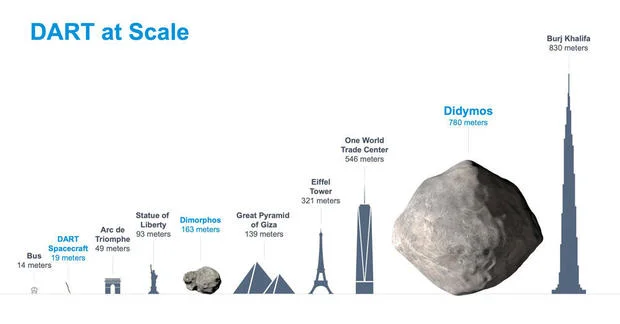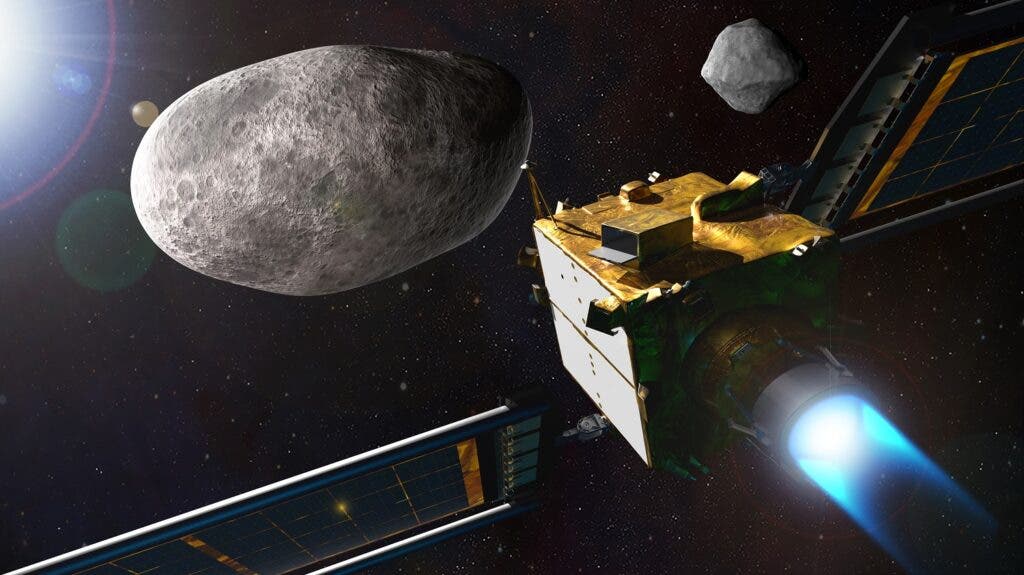The threat of an asteroid constantly looms over Earth, but it’s been over 65 million blessed years since a really big one actually hit our home planet (RIP dinosaurs). But that doesn’t mean we should be complacent. In fact, researchers are actively working on our defense in the unlikely case of an asteroid threat. This month, NASA will attempt to hit one to better understand how a dangerous asteroid could be deflected.
The space agency will attempt to pancake a craft into the asteroid Dimorphos. The ship is dubbed DART for Double Asteroid Redirection Test, and it’s a joint project between NASA and the Johns Hopkins Applied Physics Laboratory (APL).
Dimorphos is a moonlet asteroid — an astronomical object that orbits a minor planet as its natural satellite. It has a diameter of 160 meters (525 feet) and orbits the larger asteroid, Didymos, which has a diameter of 780 meters (0.48 miles). Since they only account for about 15% of all spotted asteroids, binary asteroids (where two space rocks move in tandem) are of particular interest to scientists. DART lifted off from Vandenberg Space Force Base atop a SpaceX Falcon 9 rocket last November in a US$330-million project.
As seen from Earth, the Didymos system consists of an eclipsing binary in which Dimorphos orbits the larger asteroid and crosses in front of and then back behind it. Without a second probe to compare data, scientists must measure the impact using a telescope on Earth to track the moon’s changing brightness as it orbits the Earth.
This technique will allow researchers to see how much the impact modifies Dimorphos’ orbit by comparing measurements taken before and after the collision. To maximize the quality of telescopic observations, the impact was scheduled for the fall of 2022, when the distance between Earth and Didymos will be at its shortest. Since Didymos will be some 11.3 million kilometers (6.8 million miles) from Earth at the time of impact, telescopes all over the world will be able to participate in the international observing campaign to measure the aftermath of DART’s collision.
“We don’t want to be in a situation where an asteroid is headed toward Earth and then have to be testing this kind of capability. We want to know about both how the spacecraft works and what the reaction will be by the asteroid to the impact before we ever get in a situation like that,” said Lindley Johnson, planetary defense officer for NASA, in November 2021.

In order to achieve the kinetic impact deflection, the DART spacecraft will smash itself into the asteroid at a speed of 15,000 mph (24,140 kph). It’s not good for the spaceship’s health, but it’s great for research. The force of the impact will be similar to that of a three-ton TNT explosion — certainly not nuclear, but quite large nonetheless. If everything goes according to plan, the collision will cause a change of orbital velocity of less than one percent, shortening the moonlet’s orbit by several minutes.
Earth-based observations will aid in evaluating the strategy of crashing objects into asteroids to deflect their orbit. Even though DART’s impact on Dimorphos’ orbit will be relatively minor, it should be enough to deflect the asteroid from its path significantly. If successful, this would demonstrate that this technique is capable of deflecting a dangerous asteroid on an actual collision course with Earth.
Measuring only about a meter on both sides, in the realm of satellites, DART is quite compact. When its two solar arrays are extended, its size increases to 40 feet (20 meters) in length. The ship will also carry a secondary load.
LICIACube (Light Italian CubeSat for Imaging of Asteroids), developed by Italy’s space agency, the Agenzia Spaziale Italiana, is riding shotgun and will be released from the mother craft about 10 days prior to impact. Its goal is to photograph the final moments of DART’s life.
The impact is scheduled for September 26. You can also watch the event online. NASA will live stream it on NASA TV and on its website. It also can be viewed on its accounts on Facebook, Twitter, and YouTube.



